Note: This website was automatically translated, so some terms or nuances may not be completely accurate.
The ASICS Sports Museum: Contributing to the Development of Sports Culture
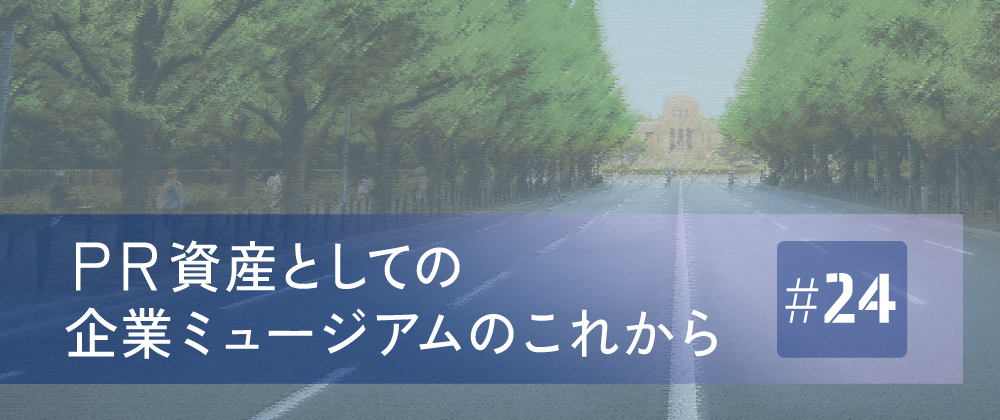
Corporate museums occupy a buffer zone spanning both the academic realm of "museums" and the business realm of "corporations." They are organizations that collaborate extensively with corporate departments such as public relations, branding, advertising, and human resources. In this series, PR professionals will introduce various museums operated by corporations, exploring their roles, functions, and potential.
Reporting and Text: Sachiko Tarumi (PR Consulting Dentsu Inc.)
ASICS is one of Japan's leading sports manufacturers. The history of the company's development largely overlaps with the development of the sports world, which is a collective of individual athletes. In fact, at the Tokyo 2020 Olympic and Paralympic Games, ASICS supported the records of many athletes from Japan and abroad, including the Japanese national teams in track and field, baseball, and wrestling, as well as American discus thrower Barry Allman and Bermudian triathlete Flora Duffy. This article introduces the ASICS Sports Museum, which showcases the company's many products since its founding and the records of athletes who have worn them, both domestically and internationally, conveying the founding philosophy that gave the company its name: "A sound mind in a sound body" (Latin: "Anima Sana In Corpore Sano").
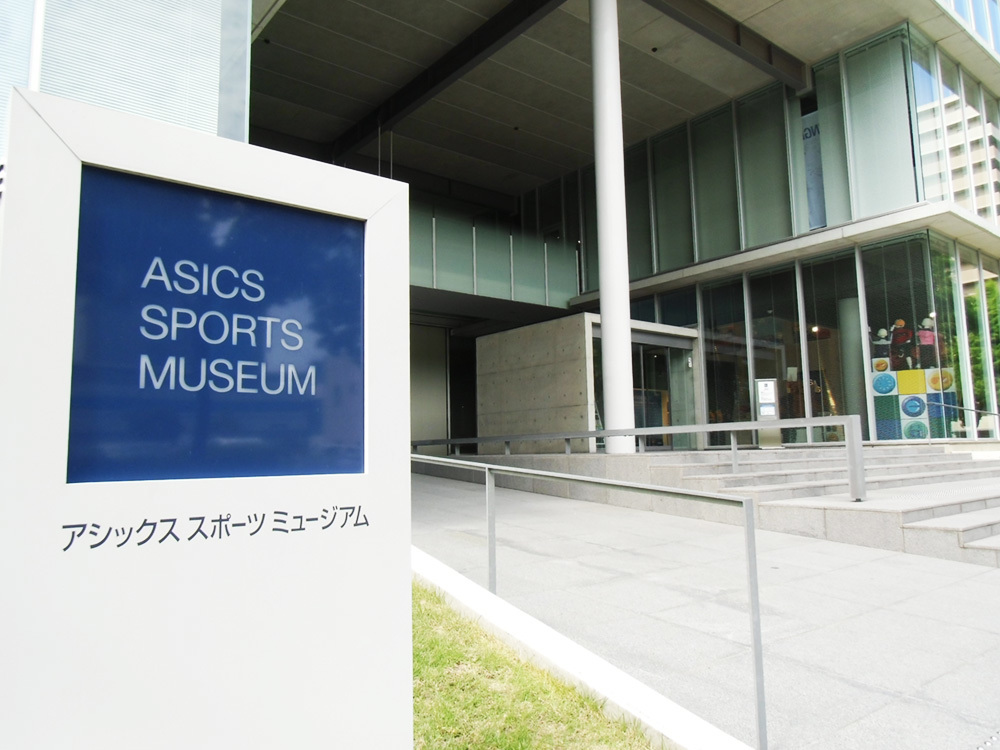
The ASICS Sports Museum is located in the East Building of the company's headquarters on Port Island, an artificial island in Kobe. It was established in 2009 as part of the company's 60th anniversary celebrations. The museum conveys the excitement generated by sports and serves as a communication hub for the company, contributing to the future of sports culture. Admission is free. Local Kobe elementary and junior high school students visit for extracurricular learning, alongside students researching sports and educators. Before the COVID-19 pandemic, shareholder tours were also held.
Numerous athletes connected to the company have visited, including women's marathon runners Naoko Takahashi and Yuko Arimori, and rugby player Michael Leitch. A large board displaying signatures from many famous athletes is displayed inside; it is already the third such board. Until 2019, before the pandemic, an average of 12,000 people visited annually, including this diverse group.
The museum consists of the "Athlete Field" on the first floor and the "History Field" on the second floor. Each floor is approximately 450 square meters. Around 350 products are permanently displayed, frequently rotated. Most are items worn by athletes supported by ASICS, featuring their autographs. Audio guides in English and Chinese are available to accommodate international visitors. Since November 2022, the museum has also offered a Japanese-English virtual tour, allowing people to view exhibits remotely, even during the pandemic.
Inspiring interest in sports through athletes' superhuman performances and shoes
The "Athlete Field" on the first floor is an attraction corner where visitors can experience the performance of highly trained top athletes. Visitors can experience their high performance through an LED speed experience system that runs lights in sync with the athletes' running and images on a large 138-inch display, overwhelming visitors and sparking their interest in athletes and sports. Visitors can experience the world's fastest speed of 9.58 seconds in the 100-meter sprint.
Looking down at the floor, you can see footprints on the field showing the average stride length of marathon runner Mizuki Noguchi during competition. Noguchi ran with a stride length greater than her height. She ran the entire 42.195 kilometers with a dynamic, jump-like stride. This corner allows visitors to experience the superhuman abilities of athletes and provides an enjoyable experience even for those who are not ASICS fans or sports fans.

This area also displays shoes for various sports supported by ASICS. Even within shoes, there are characteristics specific to each sport and athlete. For example, spikes for running and sprinting are designed only for forward movement, while basketball shoes are designed for easy lateral movement and to protect the heel to prevent sprains. Being able to compare the characteristics of shoes for different sports and athletes is a strategy to stimulate visitors' interest in sports.
The Hidden History of ASICS and Athletes in Their Shoes
The second-floor "History Field" also displays products used by the company's past contracted athletes, but its focus is on conveying the corporate philosophy and history. Half of this space is the "Athlete History" corner, which showcases products like shoes used by famous athletes ASICS has supported, displayed alongside the athletes' career histories and achievements.

The remaining half of the second floor is the "Corporate History" exhibit. By sequentially viewing sports events by era, such as the Olympics, alongside ASICS products from that time and the great achievements of the athletes who wore them, visitors can grasp the history of post-war sports development and the spirit behind ASICS' business strategy and product creation. The main display features the company's historical shoes. This section begins with an exhibit of vintage basketball shoes.
Youth Development and Postwar Reconstruction Through Sports
ASICS is a company whose name originates from its founding philosophy, "Anima Sana In Corpore Sano" (A Sound Mind in a Sound Body). However, when it was founded in 1949 during the chaotic postwar period, it was named "Onitsuka Corporation." Founder Kihachiro Onitsuka (hereafter referred to without honorifics) was originally from Tottori Prefecture, and his original surname was Sakaguchi. He passed his conscription examination, became an officer cadet, and was commissioned as an officer, but he never saw combat and remained in Japan until the war ended.
During his time as a cadet officer, Kihachiro became close friends with Lieutenant Ueda Kotoshi, who served in the same regiment. Before Ueda died on the battlefield, he asked Kihachiro to look after the Onizuka couple in Kobe, who had planned to adopt him, should anything happen to him. Kihachiro faithfully honored Ueda's dying wish and became the adopted son of the Onizuka family instead.
In Kobe's Sannomiya and Motomachi districts at that time, young people whose homes had been burned in air raids and who had lost their families were turning to delinquency. Young people gathered at the black markets, and Kihachiro reportedly agonized deeply, thinking, "I survived, and I want to dedicate my life to making Japan better, but what should I do?" He sought advice from Mr. Kōhei Hori, Director of Health and Physical Education at the Hyogo Prefectural Board of Education, who had been his comrade in the military. Hori introduced him to the famous ancient Roman maxim: "If you pray to the gods, pray for a sound mind in a sound body." This had a profound impact on him. Noting the many companies in Kobe manufacturing rubber shoes at the time, he resolved to break the youth's current plight by creating sports shoes that would foster sound minds and bodies. He founded his company with this vision.
To compete against large corporations, he adopted a strategy called the "spinning top business method," focusing intensely on a single product. He began developing basketball shoes, considered the most difficult to manufacture, and released the first pair in 1950. He continued refining the design, creating shoes with indentations in the soles the following year, inspired by the suction cups of octopus used in vinegar dishes. This was Onitsuka's groundbreaking product, unlike anything seen before.
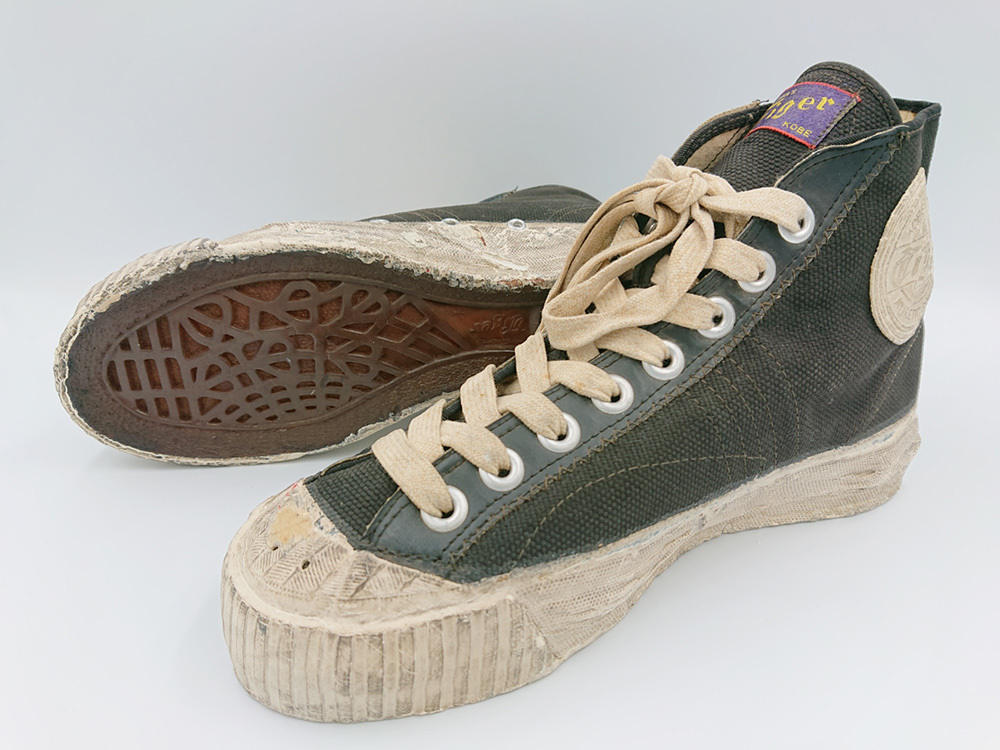
Field-First Approach Prioritizing Athletes
By visiting athletes' training and competition sites, communicating with players and coaches to identify challenges, and developing ideas to create products. This "Field-First Approach" DNA has been woven into ASICS since its founding, evolving through a scientific approach. A clear example is marathon running. As seen in the NHK historical drama "Idaten: Tales of the Tokyo Olympics," Japan was strong in marathon running even before the war, and it was a popular sport at the time of the company's founding.
Marathon runners back then were told, "You're not a real runner until you endure the pain," and it seems many had blisters burst, leaving their soles covered in blood. Mr. Onitsuka sought to understand the science behind blisters. He consulted a medical doctor at Osaka University and learned that impact heat generated when feet strike the ground and friction heat from foot movement inside shoes cause the body's lymph fluid to gather, cooling the area and forming blisters. This led him to conceive of applying the principle of an air-cooled engine to prevent the soles from overheating.
He created holes in the shoe's toe and sides to allow air to flow in and out, and added a large opening in the instep area, called the tongue, to let air in. Furthermore, he curved and raised the center of the sole. When the foot struck the ground, the hot air inside the shoe was forced out by the bellows principle. As the sole returned to its curved shape, cool air from outside entered, creating a ventilation structure that cooled the interior.
Marathon runners of the time called them "magic shoes," leading to the name "Magic Runner," which became wildly popular. Onitsuka's marathon shoes became a symbol of the company's "Summit Strategy," targeting top athletes. At the 1964 Tokyo Olympics, athletes and teams wearing Onitsuka shoes won 47 medals, including in the marathon. Since then, many Japanese marathon representatives have chosen Onitsuka shoes.
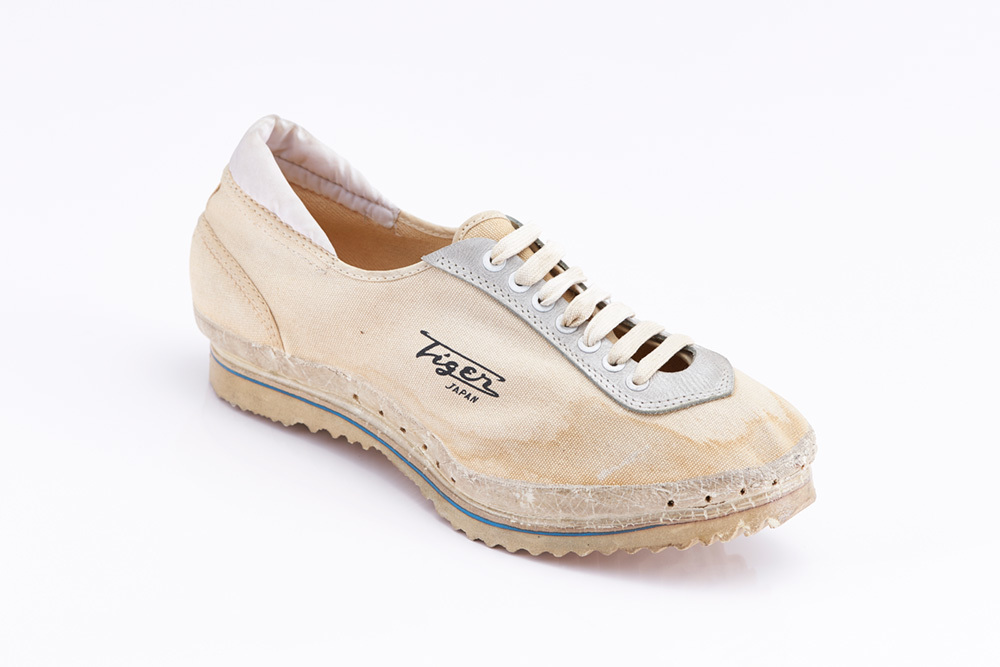
Differentiation with Competition Marathon Shoes
The company's momentum continued even after changing its name to "ASICS." At the 1988 Seoul Olympics, male and female athletes wearing ASICS shoes won gold medals. At the 1992 Barcelona Olympics, they secured gold and silver medals.
At the time, ASICS was rare in having a distinct category for marathon shoes specifically designed for racing. Most companies placed both marathon race shoes and general running shoes within their running shoe category. ASICS's number of marathon shoe models and launch frequency surpassed competitors. This was because they developed shoes tailored to individual characteristics like bone and joint alignment (alignment) and a runner's specific running style.
Furthermore, they measured athletes' range of motion and custom-made shoes for each top athlete. While shoes and injuries are closely related, many athletes switched to ASICS after suffering injuries. This approach continued into the 2000s, supporting record-breaking performances by numerous athletes both domestically and internationally, including Naoko Takahashi and Mizuki Noguchi.

Developing Products for General Runners Through a Scientific Approach
The research on the human body cultivated through top runner shoes was also applied to jogging and running shoes for the general public, whose numbers surged after the 1980s. ASICS established a solid global position even in shoes for general runners. According to Yoshimori Fukui of the ASICS Sports Museum Archive Team, running styles vary greatly from person to person.
For example, when the foot lands heel-first, a natural movement called "pronation" occurs where the heel tilts slightly inward to disperse the impact. Individuals with wider pelvises and longer legs tend to have greater pronation. Excessive inward tilt can lead to knee or ankle pain and increase susceptibility to running injuries. Therefore, ASICS categorizes running styles into three patterns and develops shoes that minimize injury risk according to each type, significantly expanding its lineup for general runners.
Established in 1985, the ASICS Sports Engineering Laboratory analyzes the characteristics of human movement in detail from every angle, using a scientific approach centered on the "human." The first-floor exhibition area displayed the "8 Major Functions of Running Shoes." These include quantifying the hard-to-measure shoe fit, plus cushioning, grip, durability, flexibility, lightness, breathability, and stability. By measuring each wearer individually, ASICS can scientifically create the optimal shoe for that specific runner. Over half a century since the Magic Runner, shoes for long-distance running have evolved this far.
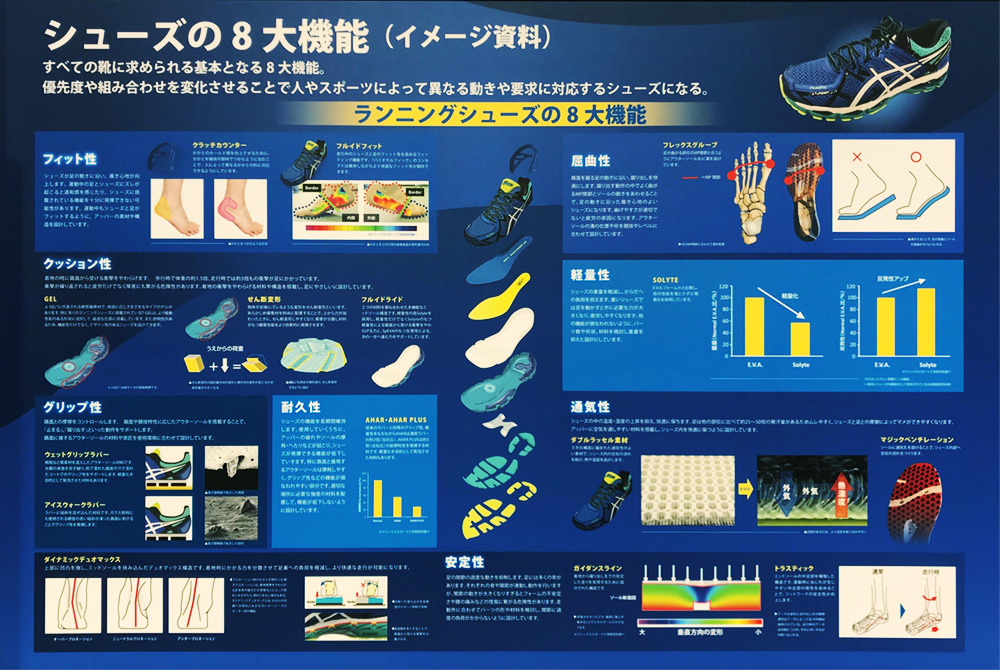
Contributing to the Community through the Healthy Development of Youth via Sports
The ASICS Sports Museum has hosted and sponsored various events to put into practice its founding philosophy: "Contributing to the community by fostering healthy youth through sports."
Examples include the "Sports Environmental Field Trip," where elementary school students learn about protecting the global environment and collect unwanted sportswear from their homes to send to refugees worldwide. Another initiative features former J.League and Nadeshiko League players serving as "Dream Teachers" (nicknamed Yumesen), sharing the importance of having dreams and the value of teamwork.
Currently, ASICS also hosts "Miniature Shoe Workshops" both locally and online. Here, participants assemble shoe parts made from scraps generated during shoe manufacturing using glue to create three-dimensional, miniature shoes approximately 8cm tall.
The design is identical to genuine ASICS brand shoes. Participants experience the joy of making things and the importance of valuing objects while creating them. This activity is enjoyable not only for children but also for adults. ASICS has also incorporated this miniature shoe-making into its new employee training program. Participants assemble nine parts, understand the structure of shoes, and learn about the fun and challenges of manufacturing.

The history of excitement born from sports, seen through generations of shoes
The ASICS Sports Museum offers a unique perspective from behind the scenes—the sports equipment developed through athlete body research. It's a place to rediscover how top-level sporting thrills were created, alongside the history of sports evolution. It truly serves as a communication hub that contributes to the company's branding by conveying the excitement of sports and contributing to sports culture. We encourage you to visit and see how sports equipment supports your favorite athletes.
[Editor's Note] (From the Web Dentsu Inc. Editorial Department)
When we think of shoes, we often picture young athletes. But that's not the whole story. ASICS' founding philosophy, "Anima Sana In Corpore Sano" (A Sound Mind in a Sound Body), embodies a rallying cry for everyone. Men and women, young and old. Shoes literally support us from the ground up.
Sport isn't just for top athletes with special talents. It's for everyone—with or without disabilities—to "walk forward." I believe ASICS, as a company, is trying to cheer on that positive spirit.
The museum conveyed a desire to support that joy.
Was this article helpful?
Newsletter registration is here
We select and publish important news every day
For inquiries about this article
Back Numbers
Author

Sachiko Tarumi
PR Consulting Dentsu Inc.
Research & Consulting Department
Senior Consultant
After working for a Japanese PR firm in China, joined PR Consulting Dentsu Inc. in 2006. Since joining, has handled media relations and international PR for social issues and disease awareness campaigns, as well as initiatives promoting Cool Japan and Japan's recovery after the earthquake. Within the Corporate Communications Strategy Division, he conducted research and consulting on corporate communications, brand strength, and ESG. Currently, in the Sustainability Specialized Department, he provides PR consulting for companies tackling climate change through initiatives like renewable energy, while also supporting efforts related to human well-being, including Diversity, Equity, and Inclusion (DE&I). He holds a Master's in International Public Relations (Cardiff University, UK, School of Journalism) and is a Certified PR Planner by the Japan Public Relations Association.




